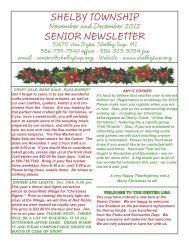RIVER BENDS PARK-WEST AND HOLLAND ... - Shelby Township
RIVER BENDS PARK-WEST AND HOLLAND ... - Shelby Township
RIVER BENDS PARK-WEST AND HOLLAND ... - Shelby Township
Create successful ePaper yourself
Turn your PDF publications into a flip-book with our unique Google optimized e-Paper software.
EXISTING CONDITIONS FOR 'ST<strong>AND</strong> 8. COTTONWOOD'<br />
Land area: 2.6 Acres<br />
Land use history: Like other parts of this Holland Ponds complex, the soils map shows this area as a former<br />
gravel pit.<br />
Forest Type:<br />
-Existing: Cottonwood<br />
-Potential:<br />
Successional trend: Cottonwood was the main tree in this relatively upland stand located between wetland<br />
areas. All were poles or small sawlogs. There were a few twisted or corkscrew willows. In the understory<br />
were sycamore, autumn olive, buckthorn and sandbar willow. Ground vegetation in the sparse forest<br />
included birch, buckthorn, marsh and swamp horsetails, Canada anemone, bee balm, goldenrod, poison ivy,<br />
tartarian honeysuckle, daisy, yarrow, heal-all, tall buttercup, aster and grasses. Vegetation in the southwest<br />
corner, devoid of tree cover, included birdfoot trefoil, crown vetch, yarrow, sandbar willow, a sycamore<br />
sapling, spotted knapweed, curly dock, staghorn sumac, common milkweed, Queen-Anne's-lace, quackgrass,<br />
English plantain, brome, redtop grass, bouncing bet, wild grape and white sweet-clover.<br />
Forest health: Trees appear to be healthy, but autumn olive, tartarian honeysuckle and buckthorn should be<br />
controlled or eradicated.<br />
Site quality: Site index is estimated at 65 for cottonwood, a moderate to good site for cottonwoods and<br />
associated species.<br />
Approximate age: 66 Size Class: Poles (5.5 - 11.5")<br />
Trees per acre: 36 Mean Stand Diameter: 9.9 in.<br />
Basal Area (BA): 15.4 Acceptable BA:<br />
Growth Rate: % Timber Quality: medium<br />
Stocking: Pole-size and small sawlog size cottonwoods make up 98% of the trees surveyed. Corkscrew<br />
willow is the other tree species.<br />
Stand volume: 3.7 Gross total cords/acre<br />
Habitat and wildlife use: As an upland area surrounded on 3 sides by wetlands, this small stand is probably<br />
used by a large variety of wildlife species, especially birds. With the small clearing in the center and the<br />
extensive shrub component, it is not surprising that woodcock were observed using the stand. Others<br />
observed were catbird, goldfinch, purple finch and cedar waxwings. Unfortunately much of the shrub<br />
component consisted of autumn olive and buckthorn, which provide abundant foods for birds but are highly<br />
invasive. These should be removed, and replaced with appropriate native fruiting shrubs.<br />
Recreational opportunities: Wildlife observation is perhaps the most likely human recreation that may take<br />
place here. Another would be gathering wild edible foods. There are some small open areas in the middle<br />
38



